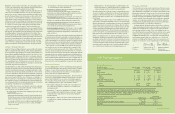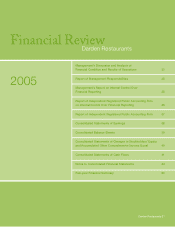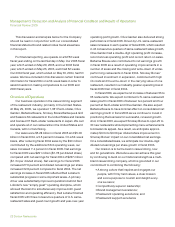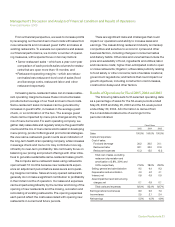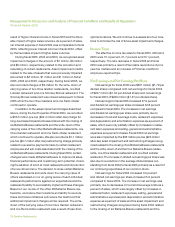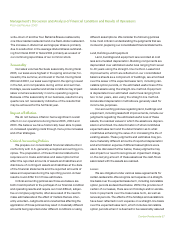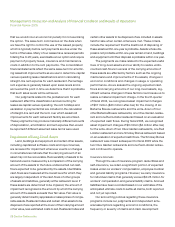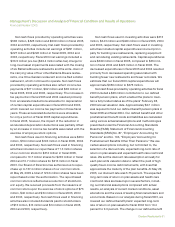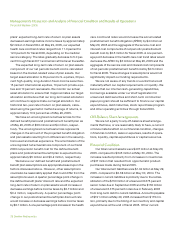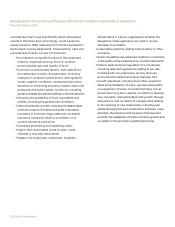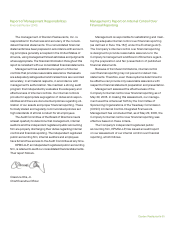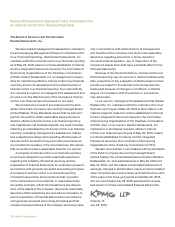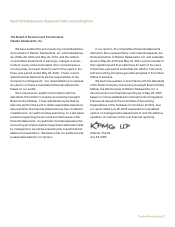Red Lobster 2005 Annual Report Download - page 19
Download and view the complete annual report
Please find page 19 of the 2005 Red Lobster annual report below. You can navigate through the pages in the report by either clicking on the pages listed below, or by using the keyword search tool below to find specific information within the annual report.Management’s Discussion and Analysis of Financial Condition and Results of Operations
Financial Review 2005
Darden Restaurants 27
write-down of another four Bahama Breeze restaurants,
one Olive Garden restaurant and one Red Lobster restaurant.
The increase in diluted net earnings per share is primarily
due to a reduction in the average diluted shares outstand-
ing from fiscal 2003 to fiscal 2004 primarily as a result of
our continuing repurchase of our common stock.
Seasonality
Our sales volumes fluctuate seasonally. During fiscal
2005, our sales were highest in the spring and winter, fol-
lowed by the summer, and lowest in the fall. During fiscal
2004 and 2003, our sales were highest in the spring, lowest
in the fall, and comparable during winter and summer.
Holidays, severe weather and similar conditions may impact
sales volumes seasonally in some operating regions.
Because of the seasonality of our business, results for any
quarter are not necessarily indicative of the results that
may be achieved for the full fiscal year.
Impact of Inflation
We do not believe inflation had a significant overall
effect on our operations during fiscal 2005, 2004 and
2003. We believe we have historically been able to pass
on increased operating costs through menu price increases
and other strategies.
Critical Accounting Policies
We prepare our consolidated financial statements in
conformity with U.S. generally accepted accounting prin-
ciples. The preparation of these financial statements
requires us to make estimates and assumptions that
affect the reported amounts of assets and liabilities and
disclosure of contingent assets and liabilities at the date
of the financial statements and the reported amounts of
sales and expenses during the reporting period. Actual
results could differ from those estimates.
Critical accounting policies are those we believe are
both most important to the portrayal of our financial condition
and operating results and require our most difficult, subjec-
tive or complex judgments, often as a result of the need to
make estimates about the effect of matters that are inher-
ently uncertain. Judgments and uncertainties affecting the
application of those policies may result in materially different
amounts being reported under different conditions or using
different assumptions. We consider the following policies
to be most critical in understanding the judgments that are
involved in preparing our consolidated financial statements.
Land, Buildings and Equipment
Land, buildings and equipment are recorded at cost
less accumulated depreciation. Building components are
depreciated over estimated useful lives ranging from seven
to 40 years using the straight-line method. Leasehold
improvements, which are reflected on our consolidated
balance sheets as a component of buildings, are amortized
over the lesser of the expected lease term, including can-
celable option periods, or the estimated useful lives of the
related assets using the straight-line method. Equipment
is depreciated over estimated useful lives ranging from
two to ten years, also using the straight-line method.
Accelerated depreciation methods are generally used for
income tax purposes.
Our accounting policies regarding land, buildings and
equipment, including leasehold improvements, include our
judgments regarding the estimated useful lives of these
assets, the residual values to which the assets are depreci-
ated or amortized, the determination of what constitutes
expected lease term and the determination as to what
constitutes enhancing the value of or increasing the life of
existing assets. These judgments and estimates may pro-
duce materially different amounts of reported depreciation
and amortization expense if different assumptions were
used. As discussed further below, these judgments may
also impact our need to recognize an impairment charge
on the carrying amount of these assets as the cash flows
associated with the assets are realized.
Leases
We are obligated under various lease agreements for
certain restaurants. We recognize rent expense on a straight-
line basis over the expected lease term, including cancelable
option periods as described below. Within the provisions of
certain of our leases, there are rent holidays and/or escala-
tions in payments over the base lease term, as well as
renewal periods. The effects of the holidays and escalations
have been reflected in rent expense on a straight-line basis
over the expected lease term, which includes cancelable
option periods when it is deemed to be reasonably assured



